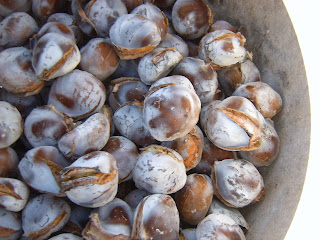I am a big believer in good food, and freshly roasted chestnuts are high on my list of good things to eat. There are several stands near my flat, but in my usual fashion, I tend to favor one over all the others. This is partly because it's near my bank and the ATM machine where I often find myself. In other words, it's convenient.
 |
| Uncooked chestnuts with sea salt in a container. |
The guys that run this stand get their chestnuts from Ronda, a lovely town halfway up a mountain, with a couple of ancient and wonderful bridges over a spectacular gorge. I asked them about it and was told you can also get chestnuts in Huelva, a town on the Atlantic coast not too far from Jerez.
The chestnuts are first slit open, then roasted over a kind of oven that looks like a stove pipe. It's filled with hot coals, and every once in a while they toss sea salt on the coals, which penetrates the chestnuts just enough to bring out their flavor.
 |
| The chestnut-roasting "oven." Chestnuts are in the pan at the top. |
 |
| Putting the roasted chestnuts in a paper cone for me to eat. |
Since the inner skin is edible, this is not a real problem.
 |
| Chestnuts roasting in the pan. |
NOTE: The guys with the stand didn't want me taking a photo of the entire stand. I think they forgot to take out their peddlers' license.
OUR NEXT BLOG will be about what the world is saying about Afro-Peruvian music, dance and culture.












